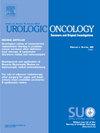Does inclusion of neighborhood variables improve clinical risk prediction for advanced prostate cancer in Black and White men?
IF 2.3
3区 医学
Q3 ONCOLOGY
Urologic Oncology-seminars and Original Investigations
Pub Date : 2025-05-01
DOI:10.1016/j.urolonc.2025.02.021
引用次数: 0
Abstract
Introduction
Black men are diagnosed with high-grade prostate cancer (PCa; Gleason sum ≥7) at greater rates than White men. This persistent disparity has led to mortality rates among Black men that are twice the rate of White men. Risk prediction tools can aid clinical decision making for PCa screening, biopsy, and treatment. However, research has not integrated neighborhood-level risk factors that are associated with rates of high-grade PCa. This study sought to determine whether inclusion of neighborhood-level variables can improve prediction of high-grade PCa over the existing Prostate Cancer Prevention Trial (PCPT) calculator.
Methods
Existing PCa cases from 2005 to 2017 were ascertained from urology, radiation, and medical oncology clinics at Fox Chase Cancer Center/Temple University Health System (FCCC/TUHS). Existing databases from patient medical records, biosamples, pathology, and neighborhood data from the U.S. census were linked via geocodes. Informed by prior studies that selected social environmental variables, a series of logistic regression models were completed to predict the probability of high-grade PCa on prespecified sets of variables from the PCPT.
Results
Our best fitting, multilevel model included PCPT variables (i.e., PSA, digital rectal exam, age, race, prior biopsy, family history) as well as insurance status, neighborhood-level poverty, residence in a high risk PCa cluster, and % of Employed Men in Protective Service Occupations. However, the AUC for this model (0.673) was only marginally improved from the initial model of only PCPT variables (0.671). Further, in separate analyses by race (White, Black) the % of Employed Men in Protective Service Occupations was only significant among White men.
Discussion
Study findings demonstrate the potential for neighborhood variables to enhance current risk prediction models and identify interaction effects revealing differences across subgroups, such as race. The lack of significant associations between neighborhood variables and Black men highlight the complexity of systemic racism and neighborhood-level variables on PCa outcomes.
纳入邻居变量是否能改善黑人和白人男性晚期前列腺癌的临床风险预测?
黑人男性被诊断为高级别前列腺癌(PCa;Gleason sum≥7)的发生率高于白人男性。这种持续的差异导致黑人男性的死亡率是白人男性的两倍。风险预测工具有助于前列腺癌筛查、活检和治疗的临床决策。然而,研究并没有整合社区水平的风险因素与高级别前列腺癌的发病率相关。本研究旨在确定纳入邻域水平变量是否可以比现有的前列腺癌预防试验(PCPT)计算器提高对高级别前列腺癌的预测。方法:选取Fox Chase癌症中心/天普大学卫生系统(FCCC/TUHS)泌尿科、放射科和肿瘤内科门诊2005 - 2017年的PCa病例。现有的数据库包括患者医疗记录、生物样本、病理和来自美国人口普查的社区数据,通过地理编码进行链接。根据之前的研究,选择社会环境变量,完成了一系列逻辑回归模型,以预测PCPT中预先指定的变量集上高级PCa的概率。结果:我们的最佳拟合多级模型包括PCPT变量(即PSA,直肠指检,年龄,种族,既往活检,家族史)以及保险状况,社区贫困,居住在高风险PCa集群中,以及在保护性服务职业中就业的男性百分比。然而,该模型的AUC(0.673)仅比只有PCPT变量的初始模型(0.671)略有提高。此外,在不同种族(白人、黑人)的单独分析中,从事保护性服务职业的男性比例仅在白人男性中显著。讨论:研究结果表明,邻里变量有可能增强当前的风险预测模型,并确定揭示亚群体(如种族)差异的相互作用效应。社区变量与黑人男性之间缺乏显著关联,这突出了系统性种族主义和社区水平变量对PCa结果的复杂性。
本文章由计算机程序翻译,如有差异,请以英文原文为准。
求助全文
约1分钟内获得全文
求助全文
来源期刊
CiteScore
4.80
自引率
3.70%
发文量
297
审稿时长
7.6 weeks
期刊介绍:
Urologic Oncology: Seminars and Original Investigations is the official journal of the Society of Urologic Oncology. The journal publishes practical, timely, and relevant clinical and basic science research articles which address any aspect of urologic oncology. Each issue comprises original research, news and topics, survey articles providing short commentaries on other important articles in the urologic oncology literature, and reviews including an in-depth Seminar examining a specific clinical dilemma. The journal periodically publishes supplement issues devoted to areas of current interest to the urologic oncology community. Articles published are of interest to researchers and the clinicians involved in the practice of urologic oncology including urologists, oncologists, and radiologists.

 求助内容:
求助内容: 应助结果提醒方式:
应助结果提醒方式:


